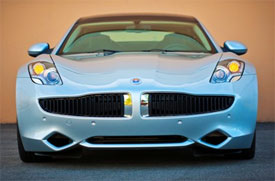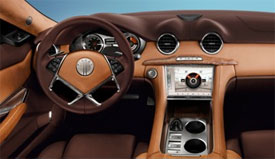2012 Fisker Karma
As we make our way to an electric-powered driving future, there are many different methods for getting us there - from hybrids, to plug-ins, to even a few full-electrics. And, while most of us are familiar with the concept of karma, most people are not familiar with the Fisker Karma. The Fisker Karma is the world’s first EV luxury sports sedan with extended range. And, as they say, what goes around comes around; so let’s find out what comes from our first go-round.
So what exactly does it mean to be the world’s first EV luxury sport sedan with extended range? Well, for the 2012 Fisker Karma it means driving up to 50 miles on electric power alone, before shifting to gas power, which comes from a turbocharged inline-4, increasing your range to up to 300-miles; but as always, your results may vary. More on that later.
The drive system is similar to Chevrolet’s Volt, but one-ups it by sending power to the rear wheels, and allowing drivers to manually select all-electric or hybrid-electric drive. And the Karma “ups” just about every other car when in comes to style, as the look is far more “sport-luxury” than “eco” with smooth lines wrapping around standard 22-inch wheels and an aluminum space frame.
 Sheet “metal” is actually a mix of aluminum and composite body panels, and the sleek roof is comprised of a solar panel that not only looks cool, but sends power directly to the batteries to aid in charging. Those batteries are located in the central “spine” of the car, and are mounted as low as possible.
Sheet “metal” is actually a mix of aluminum and composite body panels, and the sleek roof is comprised of a solar panel that not only looks cool, but sends power directly to the batteries to aid in charging. Those batteries are located in the central “spine” of the car, and are mounted as low as possible.
Exhaust tips sit just behind the front wheels, expelling spent gas from the GM Ecotec 2.0-liter turbocharged I4 engine. It sends its 260-horsepower through a Rear Differential Module and two rear-mounted electric traction motors, so there’s no direct engine connection to the wheels. There’s also no traditional transmission, but drivers can choose whether to run in EV “Stealth” mode or full-power “Sport” mode with steering wheel mounted paddles.
All combined, the system puts out 403-horsepower and almost 1,000 pound feet of torque, and that’s where the “sport” part of the equation comes in. There’s instant throttle response when the battery is full, and the Karma zips to 60 in 6.3-seconds. But even when the battery is drained and you’re running on just engine, it’s still very impressive; top speed is 125 miles-per-hour. Batteries are lithium-ion and have been a problem, causing a Karma to stop dead while being tested by Consumer Reports. All 2500 Karmas on the road will get new battery packs under warranty. That battery pack pushes curb weight to a hefty 5,300 pounds, and that calls for serious brakes. Fortunately, the standard Brembo’s are up to the task and include regenerative braking.
 The power-train might be all about the environment, but the interior environment is all about high-tech, yet it remains clean and simple. Unique items include the funky push button drive selector and a 10-inch Fisker Command Center touch-screen that manages just about every interior function. Gauges are designed with both an eye towards high-end time pieces and classic sports car dials. Real wood trim is used throughout - all certified reclaimed as sunken, fallen, or rescued. Rear seat passengers get big bucket seats with a substantial center console between them. And there’s a real, but small trunk with 6.9 cubic-feet of space.
The power-train might be all about the environment, but the interior environment is all about high-tech, yet it remains clean and simple. Unique items include the funky push button drive selector and a 10-inch Fisker Command Center touch-screen that manages just about every interior function. Gauges are designed with both an eye towards high-end time pieces and classic sports car dials. Real wood trim is used throughout - all certified reclaimed as sunken, fallen, or rescued. Rear seat passengers get big bucket seats with a substantial center console between them. And there’s a real, but small trunk with 6.9 cubic-feet of space.
The driving experience of the Karma is unique, but not foreign. There is a distinct hum from the power-train when in Stealth mode. The gas-engine kicks in fairly smoothly, but still noticeably. The suspension is a Short-Long Arm design with load-leveling monotube coil-overs and stabilizer bars, giving a surprisingly supple ride, even with the giant wheels. A 3.3 kWh battery charger is onboard and can charge the Karma on household 120 or 240-volt circuit, taking as little as 6-hours.
As for the Government Fuel Economy Ratings, they didn’t come out quite as good as Fisker had wished. The MPG equivalent is 52 miles-per-gallon combined in electric mode and 20 miles-per-gallon from the gasoline engine. The EPA also estimates only 32-miles of electric only range. The Chevrolet Volt is rated higher.
As for more shocking numbers, Karma pricing begins at a lofty $96,850 for the EcoStandard, the mid-level EcoSport comes in at $104,580, while the top level EcoChic tips the scales at $109,850. But then, early adopters always pay a price penalty.
The 2012 Fisker Karma is certainly one beautiful ride, and we’d probably buy it based on looks alone; but we think it is also a very significant vehicle. It has taken a premium-step up in the auto industry’s slow climb towards an electrified future, and done it without looking or acting like an “eco-mobile.” So, come for the styling, stay for the progress, and enjoy the ride.
Specifications
- Engine: 2.0-liter turbocharged I4
- Horsepower: 260
- 0-60 mph: 6.3 seconds
- EPA: 32 mpg electric/ 20 mpg gasoline
2025 Infiniti QX80
Infiniti’s Flagship SUV Sets A Course For Extravagance
This full-size Infiniti QX80 started out as the QX56, a hastily rebadged version of Nissan’s truck-based Armada full-size utility. That was in the early 2000s when the luxury SUV craze was exploding. It wasn’t as much as a game-changer, as it was “try to keep upper”. Now, this new QX80, Infiniti is promising to “Reimagine the luxury SUV”. Let’s see if Infiniti has turned their imaginations into reality.
Well, if over the top is what Infiniti was shooting for in the all-new 2025 QX80, mission accomplished. There’s an overall feeling of extravagance here that we haven’t experienced from Infiniti in quite some time.
It’s not just the open pore ash wood trim with aluminum inlays, 24-speaker audio, and plush quilted leather seating; there’s also nicely integrated ambient lighting, a massive glass roof, plenty of tech, lots of active driving assistance, and even chilled center console storage. Forward of that is a dual touchscreen setup; the top 14.3-inch touchscreen for infotainment sits next to the digital gauge display in a single housing; while just below, there’s a 9-inch one for climate controls.
You are reminded this is still a body-on-frame utility the moment you have to climb up into the cockpit, but there’s also the commanding view of the road that comes with that. Captain’s chairs are standard for the second row, but a three-place bench is optional with all trims except for top Autograph which comes exclusively with these climate-controlled massaging chairs, along with a touchscreen control panel. The third-row experience is great, too, with heated leather seating, and adult size room for three.
Now, there is a whole new experience coming from under the hood. The last gen’s V8 has been replaced with a new twin-turbo 3.5-liter V6 rated at 450 horsepower, 50 over the V8. More notably, torque is up by more than 100 lb-ft to 516. Transmission is a nine-speed automatic, two more gears than last year, with rear-wheel drive standard, four-wheel drive an option. Max tow rating is 8,500-lbs.
And at the test track, it did pull strongly off the line, getting up to speed in a hurry with the 0-60 sprint taking just 6.3 seconds. There is roughly 3 tons of weight to push through the quarter-mile, but that twin-turbo does it well, finishing in 14.7 seconds at 95 mph. Gear changes are incredibly smooth, while not hindering acceleration in any way.
It's an impressive looking utility from any angle.
In panic braking runs, there was some fade and a considerable amount of nosedive, but our average stopping distance of 115 feet is not bad for a vehicle as big and heavy as the QX80. Last gen, the QX80 moved from the Titan truck platform to the global Patrol SUV chassis, which shifted the vibe from budget Escalade to Lexus LX fighter. The attending improvement in ride and handling was the real bonus, and that largely continues for this gen with air suspension and Dynamic Digital Dampers on all but base QX80s. While we could certainly feel all that weight through our cone course, body roll was well-controlled and without significant oversteer or understeer.
It’s an impressive looking utility from any angle, starting right up front with the big “bamboo forest” grille. The overall shape is boxy, but all body panels are smooth; and for better or worse, Infiniti joins the flush door handle fad. Look for its “Artistry In Motion” design theme to work its way down through the rest of the Infiniti lineup. All QX80s ride on 22-inch wheels except for base Pure trim which makes do with 20s.
A full power play includes standard motion-activated rear liftgate and power operation of both second and third row seats, expanding cargo capacity from 22 cu-ft behind the third row to 59 behind the second, and a max of 101.0 cu-ft with both rows folded.
Government Fuel Economy Ratings with four-wheel-drive are not great: 16 city, 19 highway and 17 combined. We averaged 18.6 mpg of premium. That’s a much worse than average Energy Impact Score, using 17.5 barrels of oil annually, with 8.6 tons of CO2 emissions.
Driving such a PUREly LUXEurious SENSORY overload, you’ll probably be expecting people to want your AUTOGRAPH, which we’re guessing is how Infiniti came up with their grade structure; pricing starts with Pure at $84,445 and climbs to $112,590 for Autograph.
The 2025 Infiniti QX80 is a massive SUV that delivers massive amounts of power and luxury. They aimed for the moon here and have clearly blasted themselves into a much more competitive orbit in the big buck, big hauler, sport-utility galaxy.
Specifications
As Tested
- Engine: 3.5-liter twin-turbo V6
- Transmission: 9-speed automatic
- Horsepower: 450
- Torque: 516 lb-ft.
- EPA: 16 City | 19 Highway | 17 Combined
- 0-60 mph: 6.3 seconds
- 1/4 Mile: 14.7 seconds at 95 mph
- Braking, 60-0 (avg.): 115 feet
- MW Fuel Economy: 18.6 mpg (Premium)
























































